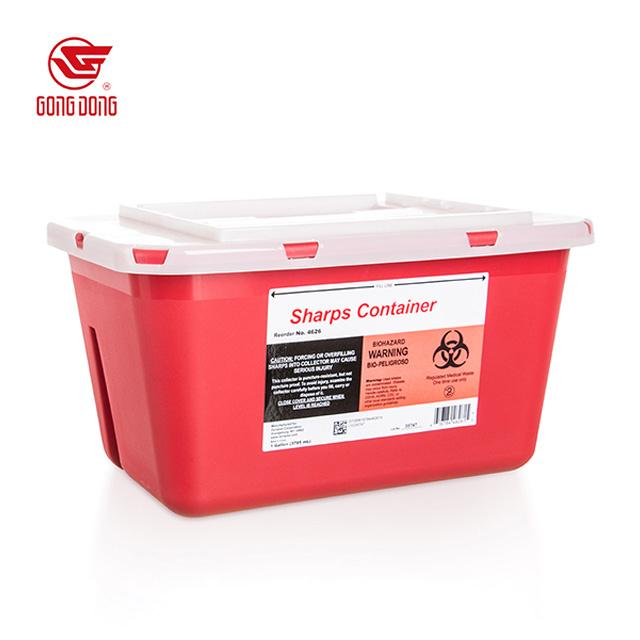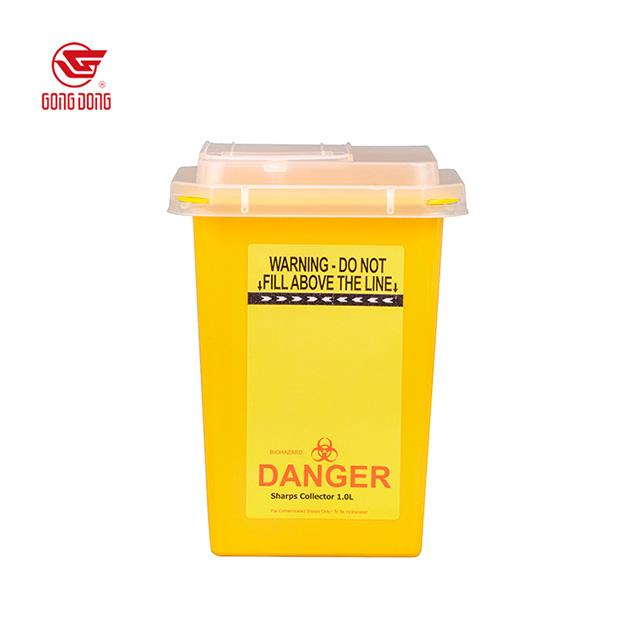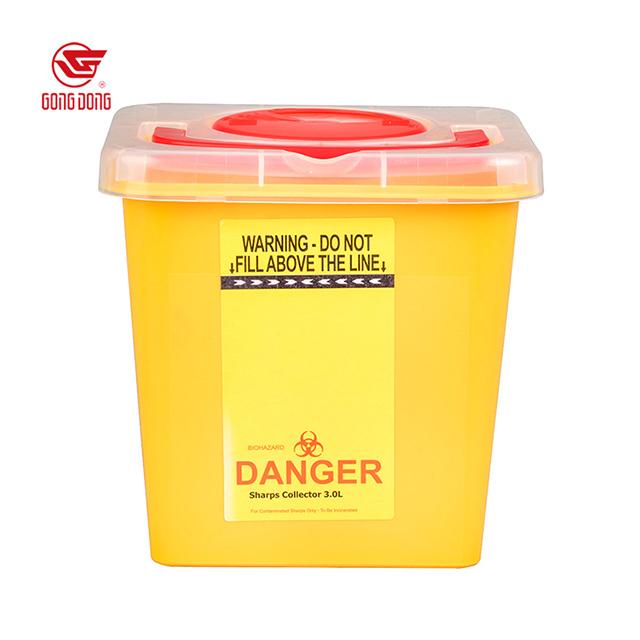

Views: 0 Author: Site Editor Publish Time: 2025-09-22 Origin: Site









You should put needles and other sharps in the sharp container right after you use them. This keeps your lab safe and follows safety rules. Many people get hurt when they do not throw away sharps the right way. About 24% of needlestick injuries happen when throwing sharps away. Around 12% happen because the container is too full. Always pick a sharp container that is strong and does not break easily. It should lock well and show when it is full. Some products like Gongdong sharp containers help you handle sharps safely and stop accidents.
Always put sharps in a puncture-proof container right away. This helps stop injuries.
Keep sharp containers near work areas. This makes it easy to throw sharps away safely after use.
Check the fill line on containers often. Change them when they are three-quarters full. This stops overfilling.
Use strong, leak-proof containers like Gongdong®. This keeps everyone safe and follows rules.
Train all staff on how to handle and throw away sharps safely. This lowers the chance of injuries.

A sharp container is a special box for throwing away sharps. In labs, you use things that can cut or poke you. These include sharp-tipped needles and scalpels. You need a safe place to put these items. Sharp containers help protect you from getting hurt. Most sharp containers are made from strong plastic. This plastic is called high-density polyethylene or polypropylene. These materials are tough and do not break easily. They also stop sharps from poking through.
Here is a table that lists materials used for sharp containers:
Material | Description |
|---|---|
Plastic | Made of high-density polyethylene (HDPE) or polypropylene; durable, inexpensive, and lightweight. |
Metal | Made of steel or aluminum; puncture-resistant and reusable, but heavier and more expensive. |
Cardboard | Heavy-duty cardboard; cost-effective for temporary use but less durable and puncture-resistant. |
Gongdong® sharp containers use plastic that sharps cannot poke through. This helps stop injuries and keeps labs safe. Each container has a lock that keeps it closed tight. Nothing can fall out once it is shut. There is also a line on the container. This line shows when it is almost full. You know it is time to get a new one.
Tip: Stop using a sharp container when it reaches the fill line. If you overfill it, sharps can stick out. This makes it easier to get hurt.
In labs, you use many kinds of sharps. These are things like sharp-tipped needles, scalpels, and broken glass. You must put all these items in a sharp container right after you use them. Here are some sharps you might use:
Hypodermic needles
Syringes (with or without attached needles)
Pasteur pipettes
Scalpel blades
Blood vials
Suture needles
Slides and cover slips
Broken or unbroken glassware that has touched infectious agents
You also need to throw away lancets, razor blades, and fragile glass tubes and ampoules. Using a sharp container for these items helps you follow safety rules. It also keeps your lab clean.
Sharp containers are very important. They keep you and your coworkers safe from cuts and pokes. They also help you follow safety rules. When you use a container with features like Gongdong®, you lower the chance of getting hurt. This helps keep everyone safe.
You help keep your lab safe every day. When you use sharps, you need to follow simple steps. These steps stop injuries and keep your area clean.
Select the Right Container
Always pick a sharps container that is strong and does not leak. It must have a biohazard symbol on it. Gongdong® Sharp Containers have thick plastic and a lock. This keeps you safe from touching sharps by mistake.
Place Containers in the Right Spot
Put sharps containers near where you use sharps. This helps you throw them away right after using them. You do not have to walk far with sharps, so accidents are less likely.
Install and Maintain Containers Properly
Make sure containers stand up straight and do not tip over. Change them before they get too full. If you overfill them, it is easier to get hurt.
Dispose of Sharps Correctly
Drop each sharp into the container right after you use it. Never push or jam items inside. Do not try to put caps back on needles or take them off syringes. Close the container when it is three-quarters full. Arrange for the right people to collect the sharps waste.
Transport with Care
When you move a full container, keep it upright and locked. Never throw sharps in the regular trash. Only use safe ways to get rid of sharps.
Tip: Always look at the fill line on your Gongdong® container. Stop using it when it is three-quarters full. This keeps you safe when throwing sharps away.
You can stop sharps injuries by following the right steps. Training and reminders help you and your team stay careful.
Protocol or Control | How It Helps with Sharps Injury Prevention |
|---|---|
Engineering controls | Use safety scalpels and self-sheathing needles to block dangers. |
Work practice controls | Use fewer needles and use safety tools with sharps. |
Standard precautions | Remind everyone to handle sharps safely all the time. |
Training helps lower the number of sharps injuries. Studies show that when you get training often, injuries go down. One study found that injuries dropped by more than half after training.
Note: Gongdong® Sharp Containers meet OSHA and WHO rules for safe sharps use. Their one-way openings and strong design help you avoid touching sharps by accident and stop injuries.
Always follow your lab’s rules for collecting and throwing away sharps. Never use a full container or skip any steps. Using sharps the wrong way can cause bad injuries. By using safe methods and keeping up with training, you help make the lab safer for everyone.

You need to choose the right size for your appropriate sharps container. The size depends on how much you use needles and other sharps in your laboratory. Here are some important things to think about:
Look at the volume of blood collection each day. If you use many needles, you need a bigger container.
Think about how often you empty the container. If you do not empty it often, a larger size helps.
Check the rules for your lab. Some safety rules, like OSHA, tell you what size you need for safe needle disposal.
Measure the space in your lab. Make sure the container fits where you need it.
Gongdong® offers many sizes, from small 1L containers to large 13L or 6-gallon options. You can pick the one that matches your needs. This helps you keep your lab safe and organized.
When you pick a container for needles and sharps, look for features that make handling safe and easy. Gongdong® gives you choices like yellow rotary caps, yellow flip caps, and red containers. These color-coded options help you work faster and avoid mistakes.
Benefit | Description |
|---|---|
Easy identification | Colors help you find the right container quickly and avoid mix-ups. |
Organized storage | Color-coding keeps your lab neat and helps you find what you need. |
Improved workflow | You save time and work better with clear color choices. |
Reduced errors | Color-coded caps help stop mistakes with needle disposal. |
You should also look for secure locking systems. These locks keep the container closed and stop anyone from opening it by mistake. They help prevent needle sticks and keep sharps away from people who should not touch them. You meet safety rules when you use containers with good locks.
Secure locks keep sharps safe and lower the risk of injury.
Only trained people can open the container.
You show you care about safety and follow OSHA and EPA rules.
Fill indicators are very important. If you overfill a container, needles can stick out and cause injuries. Fill lines show you when to stop using the container. Always change it when it is three-quarters full or when the fill line is reached. This keeps you and your team safe.
You have to follow rules for sharps containers in your lab. These rules keep you, your coworkers, and the environment safe. Many groups make these rules. The FDA, OSHA, and NIOSH all have their own guidelines. You must use fda-cleared sharps disposal containers to follow the rules. The table below lists the main standards you should know:
Regulatory Body | Standard/Guideline | Description |
|---|---|---|
FDA | 510K Notification | Needed for all disposable and reusable sharps containers, which are Class II medical devices. |
ASTM | F2132-01 | This is the standard for how strong the container is against sharp objects. |
ECRI | Guidelines | Gives advice for using sharps containers safely. |
NIOSH | Selecting, Evaluating, and Using Sharps Disposal Containers | Tells you how to pick and use the right sharps container. |
OSHA | Bloodborne Pathogen Standard: 1910.1030 | Rules for handling sharps to stop bloodborne diseases. |
General | Labeling and Maintenance | Containers must have a biohazard symbol or be red, stand upright, be changed often, and be closed before moving to stop spills. |
If you do not follow these rules, you can get into big trouble:
You might have to pay a lot of money in fines.
You could get sued or face criminal charges.
People may not trust your lab anymore.
Not throwing away sharps the right way can also make people sick:
Diseases like hepatitis B and C can spread.
Getting poked by sharps can cause health problems for a long time.
Accidents can make workers feel worried or upset.
If sharps waste is not handled right, it can hurt nature:
Germs can get into water supplies.
Pollution can harm lakes and rivers.
Bad chemicals might go into the air.
You need to make sure your sharps containers are high quality. Gongdong® makes containers with strong rules and in very clean places. This helps you trust that each container will keep sharps safe. You should check that your containers are tough, do not leak, and have clear fill lines. The rules say you must use containers that do not break or leak.
Check your containers often to make sure you follow the rules. Look at each container for cracks or damage before you use it. Always use containers that meet FDA, OSHA, and NIOSH rules. When you pick Gongdong® containers, you help keep your lab safe and healthy. You also show you care about following the rules and keeping everyone safe.
If you get hurt by a needle or syringe, act quickly. Fast action helps lower your chance of getting sick. It also helps you heal faster. Here is what you should do right away:
Wash the wound with soap and water.
Let the wound bleed a little under running water.
Do not scrub or squeeze the wound.
Dry the area and cover it with a waterproof plaster.
Tip: Never use strong chemicals to clean the wound. Soap and water are best for most sharps injuries.
After cleaning the wound, tell the senior person on duty. Make sure you know what caused the injury, like the type of sharp or if it was a syringe. Contact Occupational Health Services (OHS) for help. If OHS is closed, call the on-call microbiologist or go to the nearest emergency room. For big animal bites, go straight to the emergency room. Always let OHS know about the injury as soon as you can.
You must report all sharps injuries in your lab right away. This helps you get care and keeps others safe. Here are the steps you should follow:
Tell your supervisor about the injury right away.
Get medical help at the nearest treatment center or emergency room.
Fill out an incident report with all the details.
Use personal protective equipment when handling sharps next time.
Always throw sharps away in a puncture-resistant container with a biohazard symbol.
Reporting helps your workplace find problems and make safety better. It also lets you get medical tests and counseling if needed. Your facility should have a way to track sharps injuries and offer support. You can get more information from groups like OSHA and the CDC. They give advice on needlestick prevention and care after an injury.
Remember: Learning and acting fast after sharps injuries can lower your risk of infection. Always follow your lab’s rules and ask for help when you need it.
You keep your lab safe by following rules every day. Always handle sharps carefully. Do not leave sharps alone. Put a sharps container close to you before you start. This lets you throw away sharps right after you use them. If you use reusable sharps, store them with the sharp end covered. Only use syringes with needles for specimens if you have no other choice. Use another strong container when you move sharps.
Check your lab coat pockets before you put your hands in. Never leave sharp things in your pockets. Try to use one hand to lower your chance of getting hurt. When collecting tissue, let one person use the sharp device. Others should stand far away. Wear gloves that protect you from cuts when you touch sharps. Do not put caps back on needles before throwing them away. Drop needles straight into the container. Use cleaning tools that keep your hands away from sharps. Do not use too much force with sharp items. Pick a container that does not leak and do not fill it too much.
Tip: A good sharps safety plan keeps you and your team safe. It also helps your lab follow OSHA rules and makes safety important for everyone.
You need to check and change your sharps container often. Look at the fill line a lot. Change the container when it is three-quarters full. This stops sharps from sticking out and hurting someone. Labs with lots of sharps waste may need to change containers more often.
Use a container with a lid that fits tight and does not leak. Always put the sharp end in first. Mark the container with the biohazard symbol and the word "biohazard." Make sure the container does not break or leak on the sides or bottom. When the container is full, close the lid and seal it. You can tape it shut if you need to. Throw the container away in a trash bag, not in recycling.
Best Practice | Description |
|---|---|
Proper Labeling | Mark the container with the biohazard symbol and word "biohazard." |
Compliance with OSHA | Use a container that is closable, puncture-resistant, and leak-proof. |
Easy Vertical Drop | Choose a container with a max fill line and easy drop opening. |
Doing safety checks helps you find problems and follow the rules. Labs that do checks have fewer accidents. Checks also remind everyone to be safe and help people use better habits.
You keep yourself and your team safe by using the right sharps container. Always follow the steps for safe handling and follow all safety rules. Keep containers nearby so you can use them right away. Never fill containers too much. Pick strong, puncture-proof containers like Gongdong® Sharp Containers. Check your lab’s rules often to stay safe.
Key Takeaway | Description |
|---|---|
Proper Disposal Techniques | Use a puncture-proof container and do not overfill it. |
Availability of Containers | Keep containers near where you use sharps. |
Training and Awareness | Make sure all staff know how to handle and dispose of sharps safely. |
Quick-Reference Checklist:
Keep containers close to where you use sharps
Do not put liquids or non-sharps inside
Check the fill line often
Use containers that are strong, leak-proof, and labeled
Throw away full containers within 7 days